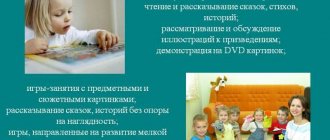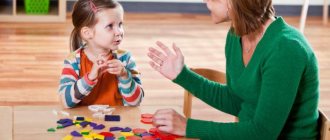My name is Maria, I'm 31 years old. I have two children: a boy and a girl. Son Alexander is 2 years old, and daughter Sophia is 4.5. We live in Moscow. I’ve been studying Maria Montessori’s method for five years, some knowledge I can put into practice, some I can’t. There is too much information on the Internet about how to develop a child at 4.5 years old, but it is not systematized. It is not always obvious which of the proposed ones to choose and why. I will share the main changes that I made to my daughter’s developmental environment and my life during two months of studying on a course on the development of children from 3 to 6 years old.
Age characteristics of a child 4-5 years old
4-5 years is one of the favorable periods in a child’s life for learning new knowledge and skills. All this is possible thanks to a sufficient level of emotional and physical development. The main features of development at 4-5 years old:
- The child learned to think figuratively and imagine. Can find something similar to a given object, selects one from several by size, color, shape and other parameters.
- Voluntary memory develops: the baby is already able to learn a poem and remember the instructions given to him. Figurative and verbal memory is formed.
- The time to concentrate increases. Now a preschooler can be occupied with one activity for 20 minutes.
- Motor skills are improved. Coordination, balance, and motor skills (both large and fine) improve.
- The drawings become more detailed, the preschooler is already given the opportunity to glue, cut out, and design according to a model and his own imagination.
- Speech becomes richer. Diction and pronunciation of sounds improves. The child easily imitates most sounds and speaks with intonation. The cognitive motive, the so-called “why mode,” is activated. A preschooler strives to master new knowledge; adults should help him with this.
- The central form of development is play activity. Now role-playing games dominate. Therefore, it is recommended to base all classes on games.
Learning colors
A child can learn all the colors by visually studying different objects. Any information can be easily absorbed in a playful way.
Red color
Look carefully at each picture with your child and repeat that the color is red.
The picture shows a red apple.
The picture shows a red flower.
The picture shows a red tomato.
The picture shows a red car.
The picture shows a red ball.
The picture shows a red pyramid.
Blue color
Look carefully at each picture with your child and repeat that the color is blue.
The picture shows a blue bow.
The picture shows a blue bucket.
The picture shows a blue dolphin.
The picture shows blue boots.
The picture shows a blue bird.
The picture shows a blue umbrella.
Yellow
Look carefully at each picture with your child and repeat that the color is yellow.
The picture shows a yellow umbrella.
The picture shows a yellow star.
The picture shows a yellow banana.
The picture shows a yellow lamp.
The picture shows yellow flippers.
The picture shows a yellow lemon.
Green color
Look carefully at each picture with your child and repeat that the color is green.
The picture shows a green watermelon.
The picture shows a green frog.
The picture shows a green hat.
The picture shows green leaves.
The picture shows a green sharpener.
The picture shows a green pea pod.
Orange color
Look carefully at each picture with your child and repeat that the color is orange.
The picture shows an orange pumpkin.
The picture shows an orange fish.
The picture shows an orange carrot.
The picture shows an orange mug and an orange saucer.
The picture shows an orange ball.
The picture shows an orange cake.
Brown color
Look carefully at each picture with your child and repeat that the color is brown.
The picture shows a brown cookie.
The picture shows a brown chicken.
The picture shows a brown briefcase.
The picture shows a brown pot.
The picture shows a brown bear.
Grey colour
Look carefully at each picture with your child and repeat that the color is gray.
The picture shows a gray wolf.
The picture shows a gray mouse.
The picture shows a gray camera.
The picture shows a gray cap.
Blue
Look carefully at each picture with your child and repeat that the color is blue.
The picture shows a blue cell.
The picture shows a blue teapot.
The picture shows a blue stapler.
The picture shows blue panties.
The picture shows a blue saucepan.
The picture shows a blue salt shaker.
White color
Look carefully at each picture with your child and repeat that it is white.
The picture shows a white bunny.
The picture shows a white mug.
The picture shows a white bird.
The picture shows a white dress.
The picture shows a white bow.
Black color
Look carefully at each picture with your child and repeat that the color is black.
The picture shows a black teapot.
The picture shows a black notepad.
The picture shows a black computer.
The picture shows a black umbrella.
After learning and reviewing all the colors, watch and do the following exercises. Your child can strengthen his new knowledge. After learning the colors, play visually with your child
Here the child will use auditory memory, visual memory, attention
Exercise one “Look and answer correctly”
Look at the following picture and answer the questions.
Is there a red pyramid in the picture?
What color is the pyramid on the left?
What color is the pyramid on the right?
Lists of what colors of the pyramid are drawn in the picture?
Exercise two “Answer the questions correctly”
Look carefully at the following picture. There are three cars drawn here. Answer the following questions carefully.
What colors are there on a police car?
What color is the flashing light on a police car?
What colors are there on an ambulance?
What color are the ambulance wheels?
What colors are on a fire truck?
What color is the flashing light of a fire truck?
Developing speech
Here are some simple but effective exercises that you can do at any time:
- “What happens...” Tell your child the characteristics of an object and ask what happens with such characteristics. Gradually, the task can be complicated by combining several characteristics at the same time.
- “What happens if...” Come up with any plot situations and wonder what will happen in this case.
- "What can be done…". Any object is taken and the question is asked what can be done with it. You can also ask what not to do and why.
- "What and where." Ask your child basic questions. For example, where is the frying pan or TV. Ask to describe all items from any room in as much detail as possible.
- Describe any animal to your baby and ask him to guess. Change roles: let the child try to act as a mystery teller.
- Play onomatopoeia. Pay more attention to problem sounds (usually s, sh, z and r).
IMPORTANT! Be sure to learn poems, songs, fairy tales, and read a lot. Discuss what you saw and heard. The development process must be continuous.
Also read about toys for children's speech development.
Games to develop logical thinking
Logical skills are well used in the following exercises:
- Generalize objects according to any characteristic (for example, find everything round, flat, yellow).
- Determine the similarities and differences between pictures or individual objects.
- Select identical objects from many.
- Assemble the constructor according to the sample.
- Find an extra item and explain your choice.
- Select paired objects, name the characteristic by which the choice was made.
- Find a way out of the maze. Such tasks are found in all children's magazines and educational publications).
Target orientation of classes
Activities that are aimed at the development of children five to six years old are extremely diverse. Classes of this type will allow you to gradually transform gaming forms into educational ones. This transition for children is carried out without stress and without problems.
Educational game for children 5-6 years old
The tasks are presented in the form of solving riddles and coloring pictures. Then the child masters the copybook. Children aged 5-6 years love to perform logical tasks.
In a children's education program that uses developmental forms, classes should achieve the following goals:
- develop cognitive interest;
- improve creative, physical and intellectual abilities;
- assignments should promote a positive attitude towards future schooling.
Memory training game
The program for the specified age group should contain the following tasks:
- on the basics of native speech, which lay the fundamental basis for teaching reading, the Russian language, and develop children’s speech.
- mathematical direction - the beginnings of arithmetic and geometry, tasks aimed at developing attention, strengthening memory and logical thinking.
- on developing an interest in nature, the ability to be sensitive to it, as well as first knowledge of ecology.
- on the study of the physical component of the simplest everyday phenomena and astronomical knowledge.
Children 5-6 years old love to play with construction sets
Children of this age are interested in fine arts classes; they like to design and make some products.
Memory is not only visual
It is human nature to remember what he sees, hears and does. Therefore, memory development should be aimed at all of these aspects.
- Visual memory is well trained by looking at pictures with their subsequent description, as well as remembering the location of objects in the room. You can ask your child what he was wearing yesterday. Develops visual memory by playing to rearrange toys: several objects are placed, and when the child turns away, they are swapped. The preschooler's task is to guess what has changed.
- Auditory memory is trained by learning nursery rhymes and rhymes. It is advisable to learn four lines a day. It is imperative to retell fairy tales and share impressions of what you saw, and everything needs to be told in detail. You can also give your child play tasks: buy in a “store” according to an oral list or set the table according to certain instructions, also spoken orally.
- Motor memory is trained during games in which you need to repeat the movements of adults. Once a certain game is learned, an adult can “accidentally” make a mistake; the child’s task is to find and correct the mistake.
Educational tasks with words
1. On the sheet in the center are written words in block letters: sea, flower, sun, snail. Match the word and the picture, draw a line.
2. Different words are written on the sheet: mom, cat, dog, dad, summer, spring, tree, flower. You need to cross out the letter A in the words. The baby learns perseverance and attentiveness.
3. Circles and triangles are drawn on a landscape sheet. The child is given the task to draw the letter M in each circle, and the letter C in each triangle.
4. “On the contrary.” An adult names any word, and the child must find the opposite meaning. For example: an adult says “hot”, a child answers “cold”, etc.
5. “A kind word.” Name the object, and the baby chooses an affectionate word to designate it. For example: ball - ball, house - house, leg - leg.
6. "Fruits and vegetables." Place various pictures of fruits and vegetables in front of the child. There are many options for games: ask the young student to put fruits in a basket. Ask to choose the vegetables from which mom makes a salad for lunch.
7. “Find the odd one out.” Tell your child a set of words in which the words belong to the same group, but one word is superfluous. The child must identify the odd one by ear. For example: tree, grass, flower, snail. The extra word is snail. The child must give an explanation of why this particular word is superfluous.
Development of attention
In order for a preschooler to be able to easily switch from one type of activity to another, concentrate his attention on work for a long time and not get tired, attention also needs to be regularly developed.
Game options:
- Find changes in the appearance of the adult and in the arrangement of objects.
- All kinds of variations of the game “edible-inedible” (shoes are not shoes, speaks - does not speak).
- Find the differences in two pictures.
- Game "Trailers". The mother names the object, the child repeats and adds his own, the mother now repeats two objects and adds a third. And so on until someone makes a mistake.
- While walking near the house, you need to remember as many details as possible, and the next day discuss what has changed in the environment.
- With your eyes closed, describe what and exactly where it is in the room.
Reading and writing
By the fifth year of life, a child already needs to train his hand for further writing at school. The same goes for reading. Simple rules will help with this. These benefits will help develop the child’s hand muscles and prepare them for further writing. You need to start with the simplest elements - tracing patterns and connecting dots. And only after that you can move on to independent writing.
The perception of the first sound in a word is necessarily worked out. To do this, you can glue letters to any objects in the house. The child’s task is to guess whether the card with the letter is chosen correctly.
REFERENCE! In this matter, Zhukova’s primer will be a good assistant for parents. It describes in detail the sound fusion algorithm and other recommendations for adults.
Musicality, sensory and movement
Any preschooler needs to move a lot. Movement helps strengthen the skeleton and muscles, improves agility, coordination, and endurance. Therefore, a child’s life should include gymnastics, exercises, dancing, any outdoor games, as well as cycling.
If you accompany physical exercises with music, this will promote the development of musicality. To develop a preschooler’s sensory perception, he needs to be given the opportunity to touch various textures and materials.
It is necessary to strive to improve fine motor skills, which will improve speech, thinking, logic and memory. Any games with small objects, including finger games, are well suited.
Games for young explorers
The child’s natural interest must be supported in every possible way. There are different ways not only to entertain a young researcher, but also to expand his life experience and horizons, simultaneously developing fine motor skills, logic, and curiosity:
- Working with kinetic sand (you can draw on it, sculpt Easter cakes from it, or just watch how it “flows” over your fingers).
- Scotch tape for a baby is a truly magical item. If you show him how it works, there is a high probability that everything that has fallen into the children's hands will be stuck to the tape.
- A hole punch, especially if it is shaped, will also fascinate the child for a long time. You can make holes in old magazines, colored paper, or sheets that the child painted himself with different colors. You can come up with fun things to do with the resulting confetti.
- Magnifier. Another "magic wand". It won’t be long before the little one stops being amazed at how objects that come under a magnifying glass turn into big ones.
- A skein of waste yarn can become a labyrinth, a cobweb, and who knows what else, in the hands of a little naturalist.
- Water poured into a basin and “flavored” with foam, as well as supplemented with washcloths, toys, and sponges, is also an excellent springboard for children’s exploration. The same can be said about a jar of soap bubbles.
- A busy board made by dad's hands can win the heart of not only a boy, but also a little lady.
- An old camera or an old phone with a working camera will awaken in any child the desire to become a photographer.
Any household items that interest the child become the object of his research. Therefore, it is advisable that safe things come into the baby’s field of vision.
Be your fidget's companion in games: help, suggest, compete, offer, set an example, be interested. This creates a warm, trusting relationship, making you the child’s best friend.
Other knowledge
A preschooler needs to develop, for example, geographical knowledge (concepts about living and inanimate nature, seasons).
It is recommended to read encyclopedias more often, look at globes or geographical maps. It is worth noting that geography is one of the most important sciences for a 4-5 year old child. By studying this science, a preschooler will find answers to many questions of interest.
Show your child paintings by Russian artists, describe every detail, its origin and purpose.










